OALP XX Seminar 3: State Government, Political Party System, and Oklahoma Water Issues
Categories: Uncategorized
Wednesday, November 11, 2020
Scribe: Emily Shuping
Oklahoma Pork Industry
Roy Lee started December 1, 1998 and has been with the Pork Council for 22 years. There have been many changes in the pork industry including lots of growth. In 1992, there were 190,000 hogs in Oklahoma and now there are over 2.3 million hogs. Oklahoma is the 10th largest in number of hogs, 5th in breeding herds, and we are predominantly a pig producing state, not a market hog producing state. We are a pig exporting state – largely because we do not have enough feed grain so it is easier to ship baby pigs to corn than corn to baby pigs.
Over the past 2.5 years, the Pork Council has spent more money on foreign animal disease preparedness and prevention than ever before. This is largely due to the growth and spread of African Swine Fever around the world. The only way to stop it is to eradicate affected herds.
The Pork Council does both checkoff funded work and public policy work. It is a great opportunity to stay connected to producers. They have about 26% of all checkoff funds collected in the state. The Pork Council collects $750,000 each year in terms of checkoff money, grants, etc., and they raise an additional $350,000 per year to fund public policy initiatives.
Roy Lee is responsible for day to day management and strategic planning, serves as their spokesperson, and is their public policy lead.
 Rob Lee – Oklahoma Pork Council
Rob Lee – Oklahoma Pork Council
Photo By: Edmond Bonjour
Shelly asked, “How did you get involved with the Pork Council?” He did not raise pigs, but he was hired to manage the association. There is a very specific skillset to run an association and those are the skills he has. His primary job is to manage issues on behalf of the industry. Key aspects of his job are relationship building, media management, issue management, organizational structure, and to protect producers’ freedoms to operate. The role trade associations play in managing issues is immense and we do not often think about it in those same terms.
Joy asked, “Who do you talk to when you go to the Capitol?” The Pork Council works very closely with ag committee chairs, transportation, and the judiciary committee. They work very closely to the Department of Agriculture, Food and Forestry to shape policy and with the Governor’s office. They work even closer with other ag groups, Beef Council, Farm Bureau, and Cattlemen’s Association. The Pork Council looks for ways to build coalitions and relationships with others on important issues that can be better tackled with more folks involved. They also protect producers from litigation coming to Oklahoma. It is hard for agriculture alone to push back on things, but when other industries get involved things can get done. Relationship building at the capital is fundamentally important. He works to educate and share information with the legislators by regularly providing information to them about the pork industry in general. He is not necessarily trying to influence policy. He builds relationships so you have an open door to their office when you need it.
Food safety issues are a big issue to push back against on a legislative level because they impact all of us in the food and agriculture industry. Changes in food safety regulations can directly impact our industries if a negative news story comes out. The Pork Council is involved because they need to make sure our industry is protected. Farmers market hubs and selling on commission is becoming more and more popular and there are a lot of moving parts when it comes to this issue. Food safety regulations are in place to protect the public and keep our food supply safe.
Robbie asked, “How does the Oklahoma Pork Council go about keeping up with demand and sustainability of the industry?” There is tremendous growth in productivity at existing facilities. Growth in pigs per litter is 1.5-3% annually. Why are we more productive? Better genetics is allowing us to have more productive sows, convert feed more efficiently, feed less grain, etc. Pork is the most widely consumed meat protein in the world. The worldwide demand for pork is astronomical. As other countries’ economies grow, they improve their diets by adding meat protein. That means more pork being added to plates across the world. We are currently exporting 28-29% of the pork produced in the U.S. around the world and are sending roughly 8% of everything we produce to China. The Chinese government is working to build their hog herd and become completely self-sufficient from a food standpoint. The U.S. is the 2nd largest producer of pork and is the world’s largest exporter of pork.
When Seaboard came to Oklahoma, their main goal was to sell pork to Japan and so they invited the Japanese in to ask them about what they needed to implement to export their pork to Japan. They became vertically integrated and kept all operations under their control to meet the demands set forth by the Japanese.
Rosslyn asked, “What is the biggest challenge facing the Oklahoma pork industry right now?” Foreign animal disease prevention is a huge challenge that he has been working on for 22 years by working on regulatory and policy issues in the state. The day we get a case of African Swine Fever (AFS) in the U.S., we will have completely lost our export market and it will wreck corn and soybean markets. COVID-19 has shone a light on deficiencies in the system. Foreign animal disease prevention is Roy Lee’s number one concern as the economic impact of AFS would be in the tens of billions of dollars. He warns everyone about the importance of producers having a premise ID and traceability program. Everyone needs to stop and think about the role we play in spreading animal disease.
Oklahoma Beef Industry
Heather Buckmaster spoke to us about the Beef Checkoff program. She grew up on a stocker operation in Hydro, Oklahoma and worked in marketing for the Colorado Beef Council for seven years. There are three things she wants us to understand about the Beef Checkoff, which is a federal checkoff and producer driven program. Those things are it is producer driven, there is oversight, and they do not lobby.
Producer Driven:
- Board of Directors: AFR, LMA, OCA, OCW, DFA, OFB and two at large seats with an application process that is approved from Secretary Arthur to open spots on the board
- Cattlemen’s Beef Board: Federal Board and administration authority of the Beef Council. Oklahoma has five members on the Cattlemen’s Beef Board. About 61% of producers are cow calf producers.
- Federation of State Beef Councils are made up of beef producers, and 58% are cow calf producers.
- Checkoff Committees and Working Groups: Board members serve on different committees such as innovation, safety, export growth, consumer trust, nutrition and health, market research working group, and investor relations working group.
- Beef Promotion Operating Committee is the big committee. Oklahoma has two on this board. It consists of Federation of SBC (10 members) and the Cattlemen’s Beef Board (10 members).
- Checkoff Contractors: American Farm Bureau Federation, Meat Importers Council of America, NAMI, NCBA, National Livestock Producers Association, U.S. Cattlemen’s Association, and USMEF.
- Cost-Recovery Basis: Contractors are reimbursed on a cost-recovery basis after a full review of their expenses through the internal financial controls at the Cattlemen’s Beef Board.
- Administrative Authority: USDA – Cattlemen’s Beef Board – Qualified State Beef Councils.
- Oversight: On a yearly basis an independent auditing firm audits the financials of the CBB.
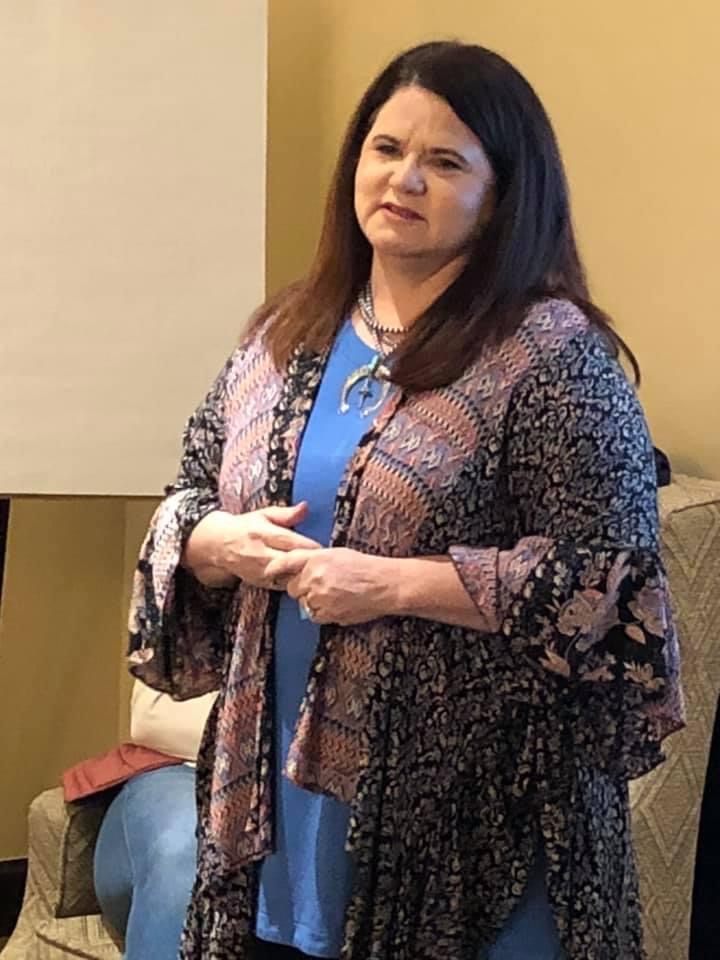 Heather Buckmaster – Oklahoma Beef Checkoff
Heather Buckmaster – Oklahoma Beef Checkoff
Photo By: Edmond Bonjour
Oversight:
- Contract with a third party accounting firm with a five-step integrity check process.
- Flow of checkoff dollars:
- Dairy, beef, veal producers pay $1 per head – State Beef Councils – $0.50 to CBB and $0.50 to Federation of State Beef Councils or direct to other SBC’s or contractors – State programs and National Programs.
- Importers and producers in six non-QSBC states pay $1 per head or equivalent – Operating Committee – National Programs.
No Lobbying:
- By law, checkoff funds CANNOT be used to influence government policy or action including lobbying, for unfair or deceptive practices, to reference any particular brand or trade name without prior approval by CBB and USDA, and cannot disparage another commodity.
What the Checkoff Can Do:
- Return on Investment for 2014-2018: Domestic Demand would have been 14.3% lower, foreign demand would have been 5.5% lower, and $1 return of $11 to producers.
- FY2020 strategy: Overarching: Beef is the top protein – Central message: real beef’s great taste and nutrition can not be replicated – Myths: we will address myths that beef is bad for your health, bad for the planet, raised in factory farms, animals are mistreated, and not as good as plant-based protein. – Champion beefs unique stories: People, protein, and pleasure.
- Local Efforts with Health Professionals, Dieticians, Doctors. Hire to give presentations at events.
- USMEF and International Marketing: Dollar matching 3-4 times. Invested in programs to enhance beef demand in countries such as Japan, South Korea, Africa, and China.
- 2020 Market Share: Mid-year for animal proteins versus Substitutes. There is no substitute for beef marketing and educational tools.
- Earned Media Outreach: Kiah Twisselman weight loss feature, 40 stories and millions of impressions.
- Issues Management: Digital command center.
- Youth Education: Ag in the Classroom, Beef in the Classroom, Masters of Beef Advocacy Program, and integrated MBA with FFA program.
- Oklahoma Ad Campaigns: Digital Marketing – dig into key demographics, interest levels, etc., eight million video views in Oklahoma, google search advertising, and only pay if you click campaigns. Video creation campaigns in Oklahoma.
- Visit www.beefitswhatsfordinner.com
Rosslyn asked about the BQA. The consumer has questions and wants to know that they are getting a safe and quality product. We are tracking consumer perceptions of beef compared to our competitors. Heather encouraged everyone to get their BQA certification. It provides opportunity to explain the program and best management practices that are part of that program, here’s how cattlemen are incorporating it, etc.
Oklahoma Wheat Commission
Chris Kirby is an OALP graduate from Class XI. She recently witnessed the most incredible harvest she has ever experienced, especially considering the early freeze when the wheat was flowering. Oklahoma had a 104-million-bushel crop, which was great as they were only expecting 80 million bushels. The OWC was established in 1964 to help educate, advocate, and market on behalf of the industry. About 50% of the Oklahoma wheat crop will be exported internationally.
In 2015, the OWC Board made an executive decision to remove themselves as a state agency and become a quasi-governmental agency. Now that they have left, 100% of time and money goes to supporting the Oklahoma wheat producer. The OWC used to be in the basement of the Oklahoma Water Resources Board. The Board moved the Commission to a new building out on NW Expressway since it was not problematic to be away from the capital since they are a non-lobbying organization. It is great to be able to bring international delegations and agricultural groups to have meetings, do tasting profiles, have producer visits, etc. They are very proud of their new facility. The paintings are called “Extending the Legacy” and were painted by a local artist, Dr. Palmer and donated by Dr. Brett Carver.
 Chris Kirby – Oklahoma Wheat Commission
Chris Kirby – Oklahoma Wheat Commission
Photo By: Edmond Bonjour
Chris gave praise for Dr. Carver and his genius for wheat breeding and genetics. The OWC, not federal, invests about $12 million dollars and 10 years in developing one variety, and Dr. Carver released five new varieties this year. The producer pays $0.20 per bushel as their checkoff contribution. About 20% of all wheat checkoff funds goes to the wheat breeding program. They have wheat variety trails occurring in 22 locations across wheat country. Dr. Amanda de Oliveira Silva, Small Grains Extension Specialist, has been with them for a year. Dr. Mischa Manuchehri is phenomenal with producers and doing weed research. Dr. Tom Royer is the insect specialist, and Dr. Bob Hunger specializes in plant diseases. Agriculture is being bombarded with false messaging. She touts gluten intolerances, etc. Wheat is the number one commodity in the state of Oklahoma. There are six classes of wheat and hard red winter wheat is the number one class grown in Oklahoma. It is great for bread and baking. Non-food uses for wheat include cattle feed, wallboard, pet food, etc.
Della Terra Pasta uses Oklahoma wheat in pasta. It is important to find which variety works best for each use: baking, pasta, etc. Mills have a list of preferred varieties in which they are interested.
They host international trade teams, milling groups, and agricultural events, hold classes in bread baking, and serve on boards (U.S. Wheat Associates, Wheat Quality Council). They share at conferences to dispel myths, and host the Jr. Wheat Show, baking contests, wheat day at the capitol, and the governor’s wheat challenge. The wheat from the governor’s wheat challenge is being milled now and we will find out in December which wheat variety will be declared the winner.
The OWC had to switch gears due to COVID-19 and held virtual trade missions, created a new website, and provided resources for at-home bakers.
Chris had several varieties of wheat on display in loaves of breach including Triumph 64, Showdown Red, Showdown White, Double Stop CL +, Sky Dance, Smiths Gold, Bakers Ann, and Green Hammer.
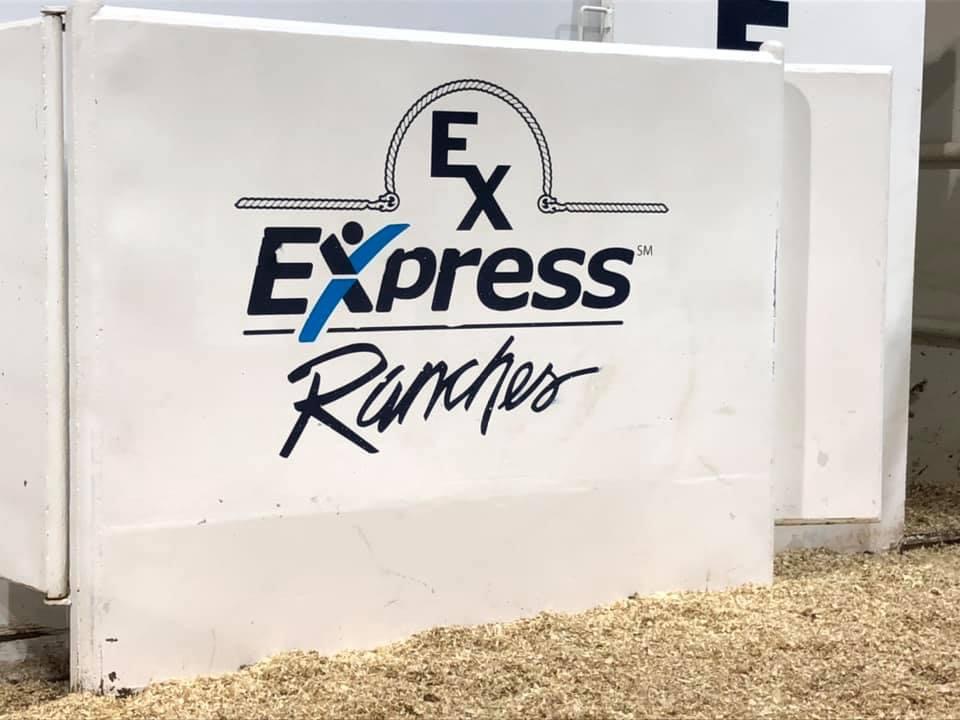 Express Ranches
Express Ranches
Photo By: Edmond Bonjour
Express Ranches
Brad Cox explained that most of the Express showmen do 10 or 12 shows per year. The best cattle stay on-site, and they help the showman get their money back out of them. This is a small part of Express Ranch operations. They start when the calves are young 6-7 months old and begin to halter break them. The cattle have the best feed and care, they stay in air conditioning, and are bathed every day. The breeds are Angus and Hereford only.
What makes our cattle better? You start by winning your class, then go to division champion, and then be selected for grand champion. Cattle are exhibited at shows and Express helps the kids that are showing their cattle as many of their showmen are junior showmen. The bulls do not show, they just promote the ranch.
They have six sales per year. The big event is in August. It is a two-day event and they sell around 700 head of cattle, generating over $400 million in 48 hours. After the cattle have been sold, that is when he starts working with them.
The juniors get to take their cattle home. That is required by trade associations but Express is very hands-on in helping the youth. They are being judged for soundness and the judge is trying to predict the quality of the meat and muscle.
Express is the premier seed stock operation in the nation. They flush eggs out of a good cow and impregnate them into other cows. The highest priced bull is $350,000 and the average straw cost is $15,000- $17,000. They have a full-time embryologist on staff.
Just Right Alpacas
Jon and Janice Robinson shared that alpacas can add another stream of income to an existing operation via agritourism and/or education opportunities. This operation is vertically integrated. They encourage producers to take their operation full circle and use the fiber as well as the animal. They use the manure to fertilize gardens.
Alpacas are very stoic and will not indicate they are sick, so it is important to watch their droppings which typically come out in pellets, because you know it is a good indication of the health of the animal. Body scores can be checked very quickly. They like to eat grass shoots but can sometimes get parasites. No pesticides are used on the land. They fertilize with nitrogen, phosphorus, and pot ash. They use a forage Bermudagrass and mow the land.
Why alpacas not llamas? Llamas weigh 250-300 pounds and are much harder to handle. Also, the fiber and hair coat on the llama must be de-haired and it is a lot of work and costly. They have raised most of their alpacas except for the white ones. They have both Huacaya and Suri types.
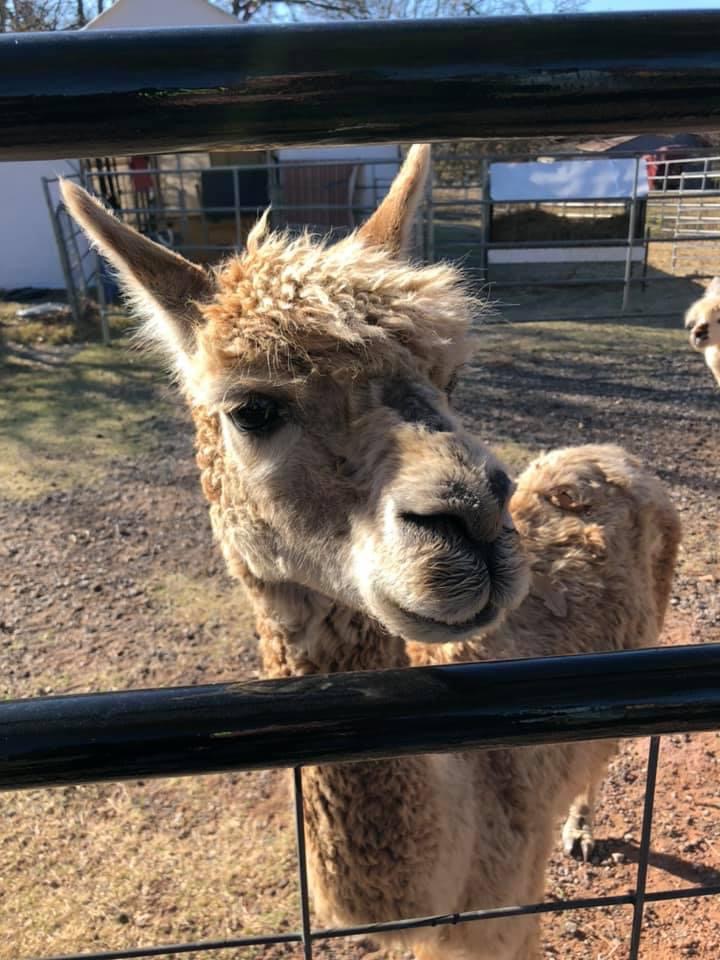 Just Right Alpacas
Just Right Alpacas
Photo By: Edmond Bonjour
Alpacas are natural breeders. There is no embryonic transfer. They started with breeding and it is important to have a herd of 3-5 head. They are ruminant animals and weigh anywhere from 175-200 pounds. Alpacas are social and love each other. Jon recommends starting with three because of their social nature. Feral dogs and coyotes are their biggest problem. Babies are born in springtime or early fall. Breeding occurs up to December. The gestation period is 11.5 months, and therefore only one baby per year.
There are 250,000 alpacas in the United States. The most commercially valuable fiber is white. In Oklahoma, you will need a shady place in the summer, fresh water, and a 5-foot no-climb fence around the perimeter of the pasture to keep them safe. You need good water and electricity. You want to pay for a quality, registered animal. It gives you an idea of lineage and what to expect for fiber quality. You can get started for about $5,000 and you will usually make about $1000 after the first year. You can have 3-5 alpacas per acre.
There are 32 ranches listed in Oklahoma. If you decide to purchase, buy from someone near who is a mentor and can help answer your questions. Oftentimes a veterinarian is called when it is a non-medical issue and can be taken care of from a management standpoint.
Community Service Project
We picked up branches and downed trees from the ice storm for a 102-year-old woman in Jones, Oklahoma.
 Class XX Serving the Community
Class XX Serving the Community
Photo By: Edmond Bonjour
Thursday, November 12, 2020
Scribe: Meg Stangl
We started at our State Capitol with Kirby Smith, Chief of Staff for Lt. Governor Matt Pinnell. Kirby grew up in the small town of Washington, Oklahoma with the oil and gas industry and cows and wheat were all around her. She was in OALP Class XVII and says the two things she got out of the class were diversity and networking. Kirby served as the Field Representative for Congressman Frank Lucas, Third district of Oklahoma, before coming to the state Capitol. She spoke of the daily challenges and new challenges that have arisen due to COVID-19. An ongoing challenge is the Lt. Governor’s staff budget of $400,000, compared to the Governor’s budget of 3.7 million. She is currently the only full-time employee to the Lt. Governor, but really needs two more people. Some tips for approaching legislatures were shared – always meet them on your turf, support them by showing up at town hall meetings, morning coffees, etc. and don’t neglect the staff as they are “the gatekeepers” to the legislatures. She gave us a little insight to Lt. Governor Pinnell, describing him as super invested in family and that he never forgets them and attends all his children’s activities.
 Kirby Smith – Chief of Staff for Lt. Governor Matt Pinnell
Kirby Smith – Chief of Staff for Lt. Governor Matt Pinnell
Photo By: Edmond Bonjour
We next heard from Representative Dell Kerbs, Shawnee, District 26. He was elected in 2016 and has held the position of House Chair for the Agriculture Committee for the last two years. He spoke highly of the CARES Act allocation of $10 million for meat processing needs in our state. Rep. Kerbs then gave us some insight into the “bills filed process.” Between the House and Senate, there will be approximately 3,000 bills (each House member can file eight, Senate members do not have a limit). Out of that 3,000 submitted, approximately 2,000 will get to committees, less than 1,000 will reach the floors in their respective sides, and maybe 500 of those will make it out of chambers to the governor. Only 250-300 will be signed by the governor. He also spoke of how the agriculture industry is always under attack and is inconstant battle in which he enjoys fighting. Kerbs stated that he likes to make changes and see it through. He left us with the words of a wise old man – “no deposit, no return.”
 Representative Dell Kerbs, Shawnee, District 26
Representative Dell Kerbs, Shawnee, District 26
Photo By: Edmond Bonjour
Our trip to the State Capitol ended with a renovation tour led by Trait Thompson, Oklahoma Capitol Project Manager. The Capitol was built in 1917 at a cost of $1.5 million. There was no dome installed as that cost alone would have been $250,000 at the time. In 2002, the dome was completed. The total cost of the renovation will be around $280 billion and is on track to be completed in 2022. A museum will be part of the remodel and this is being done in partnership with the Oklahoma Historical Society.
We then headed to the Oklahoma Farm Bureau (OFB) headquarters and enjoyed lunch in their boardroom. During lunch we had a brief overview of the workings of Oklahoma Farm Bureau from Thad Doye, Executive Director of OFB, and Dustin Mielke, Vice President of Communications and Public Relations. The OFB has a presence in all 77 Oklahoma counties. Some of their community involvement programs include the ATV and 4-wheeler safety programs, and the protein meat sticks for the weekend backpack program for school-aged children.
 Thad Doye, Executive Director of OFB, and Dustin Mielke, Vice President of Communications and Public Relations
Thad Doye, Executive Director of OFB, and Dustin Mielke, Vice President of Communications and Public Relations
Photo By: Edmond Bonjour
After lunch, our first speaker was Owen Mills, Director of Water Planning at the Oklahoma Water Resources Board (OWRB). He spoke of Oklahoma’s Comprehensive Water Plan (OCWP). The OWRB was formed in 1957 after the terrible droughts during that time. It is made up of four divisions – Administration, Financial Assistance, Water Quality and Monitoring, and Planning and Management. Nine board members sit on the board. The Financial Assistance division assists communities and rural water districts with loan and grant programs for financing water and wastewater infrastructure improvements. The Water Quality division oversees the quality and quantity monitoring of the state’s surface and groundwater resources and promulgates water utility standards. The Planning and Management Division’s responsibility is on water quality. This division oversees water rights, the OCWP, water planning assistance, dam safety, floodplain management, water well drilling and hydrologic studies. Mills spoke of Oklahoma’s future water supply challenges which include economic development, population growth, future water needs, competing water interests, infrastructure needs and costs, vulnerability to drought/flooding, and water for tourism, recreation and wildlife. The OCWP covers 50 years. Mills stated that in 2010, Oklahoma used 1.8 million acre feet of water and it is estimated that in 2060, Oklahoma will use 2.5 million acre feet of water. One-acre feet of water is equal to 326,000 gallons.
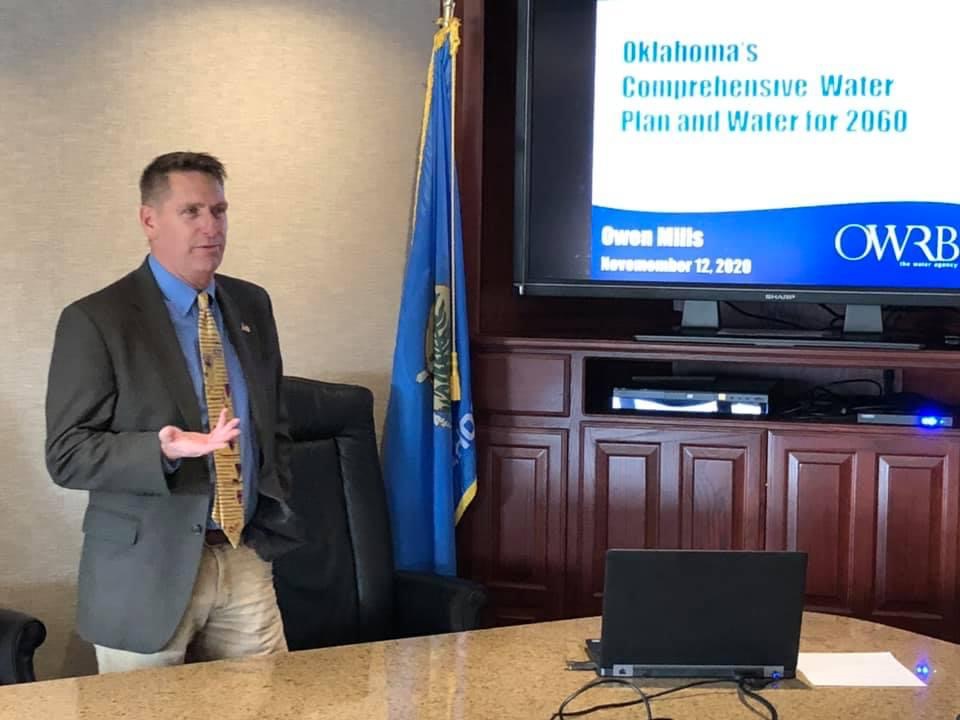 Owen Mills, Director of Water Planning at the Oklahoma Water Resources Board (OWRB)
Owen Mills, Director of Water Planning at the Oklahoma Water Resources Board (OWRB)
Photo By: Edmond Bonjour
Jeri Fleming, Owner of Dragonfly Consulting, LLC was our next speaker via Zoom. She spoke on Nonpoint Source Pollution (NPSP) water issues within Oklahoma. A watershed is an area of land when water falls on it, it all drains to one area, such as a lake, creek, river, or gulf, to name a few. In a natural environment watershed, rainwater is absorbed by 25% shallow infiltration, 25% deep infiltration, 10% runoff, and 40% evaporation. In an urban environment those percentages are 10, 5, 55, and 30%, respectively. In 2018, the impacts from NPSP in Oklahoma resulted in 11,140 miles of stream being classified as impaired. The impairments included 69% due to excessive pathogens (bacteria), 22% turbidity, 22% law dissolved oxygen, and 18% total dissolve solids. In 1972, the Clean Water Act was passed and in 1982 was amended to address nonpoint sources. This program is overseen by the Oklahoma Corporation Commission. She spoke of “Best Management Practices” for nonpoint source pollution. For urban areas, this includes rainwater harvesting, rain gardens, riparian buffer zones, lawn care practices and education. For rural areas, it includes riparian buffers, healthy soils, wildlife buffer strips, no-till and over crops, livestock management, fertilizer, pesticide use, and education. Fleming reported that these best management practices do help as a study on the Neosho watershed reduced nitrogen and phosphorus by 22%. She concluded in stating that Oklahoma is leading the nation in implementing the aforementioned “Best Management Practices” to reduce nonpoint source pollution.
After a short break, we heard from Neal McCaleb, Chairman of the Board for Chickasaw Nation Industries. He gave us a brief history of the Tribal Settlement and tribal sovereignty. There are 38 federally recognized tribes in Oklahoma. These tribes have a $12.9 billion impact on our state, provide $4.6 billion in wages and benefits to Oklahoma, with 96,000 job opportunities in our state. McCaleb spoke of the gaming compact made with the state of Oklahoma in 2005, where the tribes could operate casinos and pay no tax but there would be an exclusivity fee paid by each tribe. Over $1.5 billion in fees have been paid to the state since 2005. The tribes have had taxation issues with tobacco sales, gasoline, and oil and gas production. There continues to be big controversy over water rights.
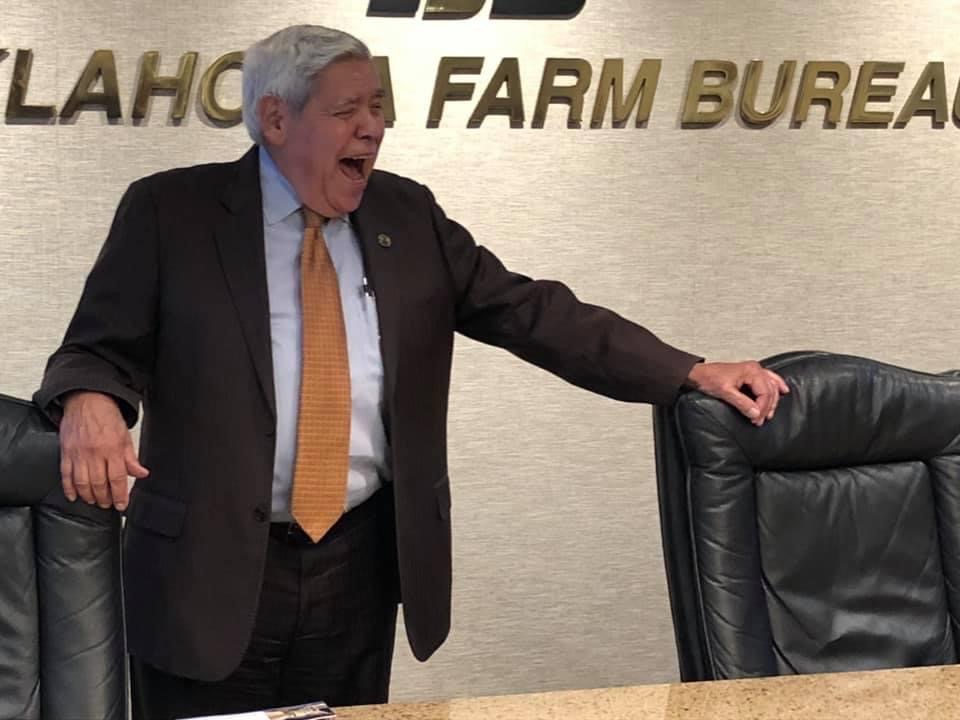 Neal McCaleb – Chairman of the Board for Chickasaw Nation Industries
Neal McCaleb – Chairman of the Board for Chickasaw Nation Industries
Photo By: Edmond Bonjour
Kevin Wagner, Director of Oklahoma Water Resources Center, then spoke on agricultural irrigation, conservation, and water quality. Under the federal Water Resources Act, the Oklahoma Water Resources Center was established at Oklahoma State University in 1965. It was formed with four principles in mind – research, outreach, educate, and cooperate. The center is tied to the Oklahoma Extension Program and is a resource for all Oklahomans. Their focus areas are water sustainability and security, watershed management, education, and outreach. Wagner told us that in 2012, House Bill 3055 established a statewide goal to consume no more fresh water in 2060 than our state consumed in 2010. We will need to be 30% more efficient in our water usage to meet this goal. Education, irrigation, water conservation, and alternate water usage are the main areas to focus on. Currently, there is an Oklahoma Master Irrigation Program being created with the first training scheduled early next year.
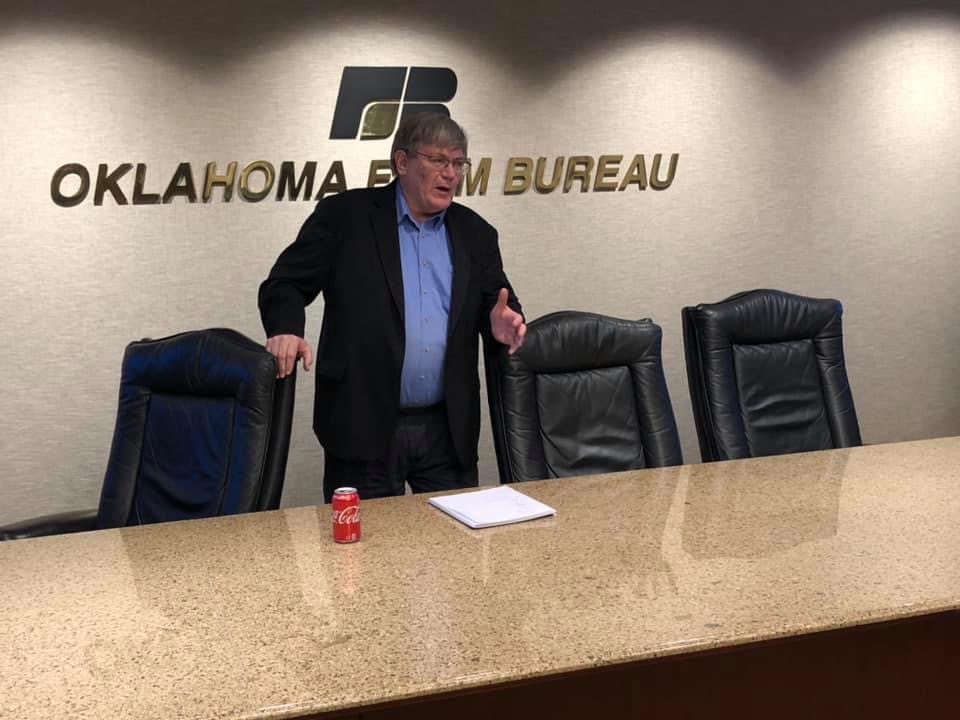 Rodd Moesel – President of the OFB Board of Directors
Rodd Moesel – President of the OFB Board of Directors
Photo By: Edmond Bonjour
To conclude our speakers for the day, we heard from Mr. Rodd Moesel, President of the OFB Board of Directors. On the political front, he mentioned the state budget deficit, urban issues, ad valorem taxes, and the pending McGirt Case. He stressed the importance of all state agriculture groups working together to keep our state moving forward. Other issues that OFB are working on include rural health care, broadband availability in rural areas, the future change of agricultural leadership at the federal level, and the upcoming redistricting of our state.
The day ended at Charleston’s Restaurant where we all enjoyed a delicious steak meal provided by the Oklahoma Beef Council and Heather Buckmaster.
Friday, November 13, 2020
Scribe: Thomas Walraven
Meriruth Cohenour, Director of Market Development at ODAFF, previously served as the Communications Director for the Pinto Horse Association and was an Equine Instructor at Redlands Community College. She attributes her career at ODAFF to being a part of OALP Class XVI. Agritourism is a growing sector in Oklahoma that offers entertainment while providing education. The Made in Oklahoma Coalition is a public/private program that is funded separately by the legislature. The objective is to increase marketing of brands that are made in Oklahoma. The Made in Oklahoma Program is a free program that provides cost-sharing opportunities for any business that grows or processes in Oklahoma. The International Marketing program focuses on trade while the Market News division provides a weekly market report for commodities. Economic Development provides grants not to exceed $10,000 and loans (can be >$10,000) at no interest. These are focused on agricultural enhancement and development.
Melody Aufill, Ag in the Classroom Coordinator, was a member of OALP Class XVIII and has been coordinating the program for 4.5 years. She previously was a teacher. We each built a barn-shaped box with materials for third graders and were encouraged to give our material to a teacher. This box contained multiple items from a game to tear sheets and coloring books. Described as one of the most successful and sought-after programs, it reaches 1000s of students each month.
 OALP XX Members Grant Mason and Claudia Humphreys testing out the ‘Ag Career-Opply’ board game
OALP XX Members Grant Mason and Claudia Humphreys testing out the ‘Ag Career-Opply’ board game
Photo By: Edmond Bonjour
Justin Cooper is a Staff Biologist in Wildlife Services. This division has 50 employees and has a cooperative agreement with USDA that allows mitigation of wildlife versus. farmers. It started in 1915 for rodent control. There are 20 field stations that focus on birds to red wolves. During the 1970-80s, rodent control was primarily for beavers. Since early the 2000s, feral hogs are the primary focus and the goal is simply to hold the population. Oklahoma has feral hogs in all 77 counties. Justin emphasized that hunting is not control! To hold the population steady, 70% of hogs need to be removed each year. There are an estimated 2 million in the state currently. They have grown due to “sport hunting” and continue to cause major crop damage and spread disease. Currently, they have four fulltime employees, three helicopters, one fixed-wing aircraft, and 55 camera systems all dedicated to feral hogs.
 Justin Cooper – Staff Biologist in Wildlife Services
Justin Cooper – Staff Biologist in Wildlife Services
Photo By: Edmond Bonjour
Kenny Naylor, Director of Consumer Protection Services, has served ODAFF for 20 years. This division currently has 18 field staff and 20 office personnel. They handle pesticide and product registry, weed free hay, fertilizers, feed manufacturing, tail-water sampling, stream monitoring, and weights and measures. This division is also responsible for scrap metal, grain warehouses. and hemp. These wide-ranging areas require the division to work with FDA, USDA, and EPA.
Mark Goeller, State Forester and Director of Forestry Services, is an OSU graduate and has spent time in New Mexico and Colorado. He has been with ODAFF of 36 years. Their overall mission is to manage, enhance, and protect Oklahoma’s forests. The state is home to 12.8 million acres or 28% of the state is forest. Revenues run about $5.1 billion annually and it employs 19,000 people with about $1 billion in payroll. Broken Bow is home to the largest OSB plant in North America and Valliant has the largest paper mill in the world. Forest management focuses on disease and insects in addition to weather like ice storms. Currently, 13 million acres are under conservation and 61,000 acre per year are reclaimed. Oklahoma has a “good neighbor” agreement with the federal government for management. Roughly 900 stewardship plans exist. Broken Bow forests see 150,000 visitors each year. The fire program is a major part of the division. In the last 5 years, ODAFF has worked 2 million burned acres. Oklahoma is #7 in the nation for homes at risk of wildfires. ODAFF responds to about 930 fires a year. Both Oklahoma City and Tulsa Fire Departments are trained for wildfires.
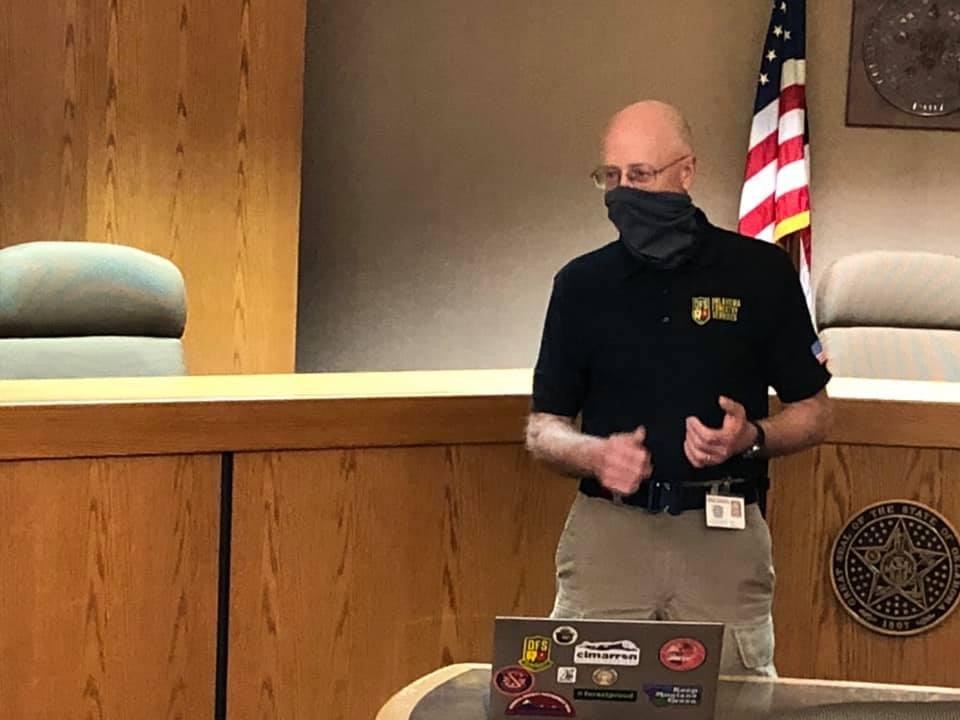 Mark Goeller -State Forester and Director of Forestry Services
Mark Goeller -State Forester and Director of Forestry Services
Photo By: Edmond Bonjour
Jenna Brinlee, Coordinator of the Made in Oklahoma Program, gave an overview of the program and introduced LeAnn Jenkins who taught us how to make soy wax candles.
LeAnn Jenkins, owner of Soy Candle Cottage, LLC, started her business because she wanted soot-free candles. Soy wax burns cooler and longer. Oklahoma grows about 440,000 acres of soybean a year, 5th in the nation.
Blayne Arthur, Oklahoma Secretary of Agriculture, has worked under two previous secretaries of Agriculture. She addressed us over lunch and focused on the department’s response and preparation to COVID-19. She particularly focused on live animal harvesting and the grants that were made available under funds the state received from the CARES act. ODAFF has 400 employees.
 Blayne Arthur – Oklahoma Secretary of Agriculture
Blayne Arthur – Oklahoma Secretary of Agriculture
Photo By: Edmond Bonjour
Dr. Rod Hall, State Veterinarian, has worked at ODAFF for 14 years. “To protect the livestock of Oklahoma” is his mission. This occurs mainly through regulation with 13 livestock inspectors. Like other divisions, they work closely with federal employees and USDA. They monitor disease outbreaks in livestock and are responsible for emergency management should an outbreak occur. All vaccines must be licensed with ODAFF to be sold in Oklahoma.
Caleb Whitcomb is an Environmental Program Specialist in the Agricultural Environmental Management Services Division. This division was established by legislation in 1997 with its primary focus on CAFOs (Concentrated Animal Feeding Operations). They particularly work with poultry feeding operations, poultry waste applicators, carcass disposal, and compost. In addition to traditional feeding programs, this division also has authority over commercial pet breeders, defined as any breeder who has 11 or more intact females.
 Caleb Whitcomb – Environmental Program Specialist in the Agricultural Environmental Management Services Division
Caleb Whitcomb – Environmental Program Specialist in the Agricultural Environmental Management Services Division
Photo By: Edmond Bonjour